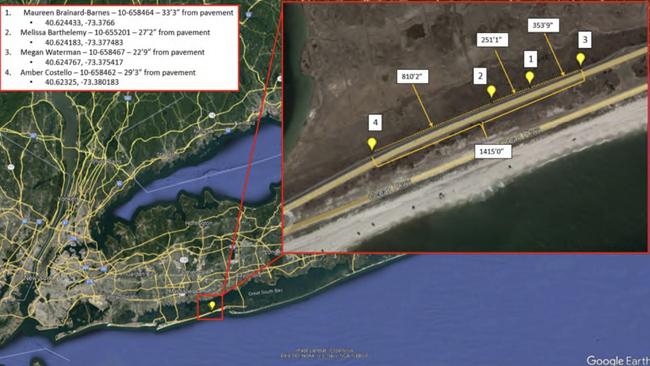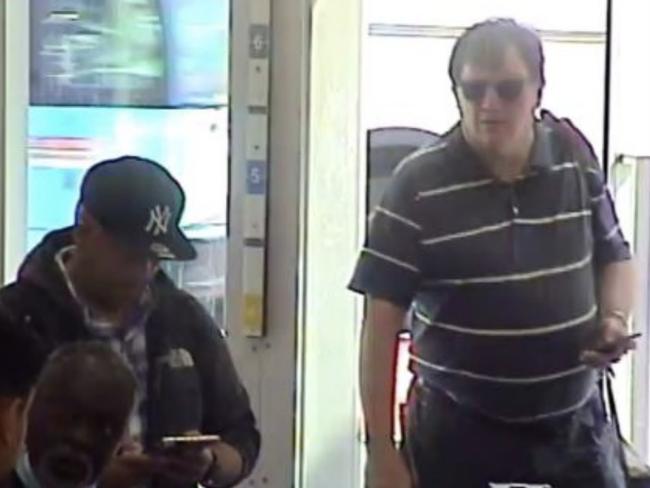Gilgo Beach killings: Police launch new search in woodlands
There’s been a major update in the investigation into 11 bodies found in Gilgo Beach, New York, which led to the arrest of an architect.
World
Don't miss out on the headlines from World. Followed categories will be added to My News.
Police have launched a new search in woodlands on Long Island in connection to the infamous Gilgo Beach killings.
NYPD officers – including a K-9 unit – and local police combed an area near the town of Manorville, local news outlets reported.
Officers were also searching along a road that cuts through state land — which is only accessible for permitted hunters, according to the New York Post.
A Manorville resident told local media that a body had been found on Tuesday local time – but police would not confirm this.
“The Suffolk County Police Department, the New York Police Department and the New York State Police are working with the District Attorney’s Office on an ongoing investigation,” according to a statement from Suffolk County District Attorney Ray Tierney.
“We do not comment on investigative steps while they are underway. We will make further statements when appropriate.”

The Gilgo Beach serial killings were a series of killings between 1996 and 2011 in which the remains of 11 people were found in Gilgo Beach, located on the South Shore of Long Island, New York. Most of the known victims were sex workers who advertised on Craigslist.
Rex Heuermann, a father-of-two who worked as an architect in Manhattan, was arrested last July for four of the killings.
The corpses of the four women Heuermann stands accused of killing — Melissa Barthelemy, 24; Megan Waterman, 22; Amber Costello, 27; and Maureen Brainard-Barnes, 25 — were found in the roadside brush along a quiet stretch of Ocean Parkway in 2010.
All four were believed to be sex workers when they vanished at different points between 2007 and 2010.
HOW A SERIAL KILLER HID IN PLAIN SIGHT FOR A DECADE
As the sun set on a humid day, Rex Heuermann left his office and joined the throngs of New Yorkers on Fifth Avenue, a couple of blocks from the Empire State Building.
The architect slung his bag over his shoulder and set off home to Long Island, when suddenly a man in a suit bumped into him. Several more quickly surrounded Heuermann, and as unsuspecting pedestrians brushed past, the 59-year-old was arrested.
He didn’t put up a fight; he didn’t even have much to say until he was processed at a nearby jail and asked: “Is it in the news?”
It was the headline New Yorkers had hoped to read for more than a decade. Police had caught the Long Island serial killer.
Since 2010 and 2011, when the bodies of nine women, a man and a toddler were found near Gilgo Beach, the case had terrified locals, mystified authorities, and been glorified in TV shows and podcasts.
So last year’s arrest of Heuermann brought relief to a community desperate for answers. But it also reignited painful questions, none more important than this: why did it take police so long to find a man who was hiding in plain sight?

Let’s rewind to 2010. Police officer John Malia and his dog Blue were scouring Gilgo Beach for missing woman Shannan Gilbert, only to discover the body of Melissa Barthelemy. Two days later, they helped find three more: Megan Waterman, Maureen Brainard-Barnes and Amber Lynn Costello.
They were all petite, aged in their 20s, and were working as escorts. They had contacted someone who used a burner phone before their deaths. Their bodies were bound in burlap and positioned the same way.
While more human remains were found, including Gilbert’s body a year later about 12km away, the links were strongest between the so-called Gilgo Four. And at the outset of the investigation, detectives identified a case-making lead.

The night before Costello went missing, one of her clients had visited her nearby home, only to be scared away by a housemate. When police came knocking, the housemate explained the man returned the next evening – and he recalled his distinctive appearance.
Costello’s client looked like an “ogre”, he said. He was about 193cm tall, in his 40s, with dark bushy hair and 1970s-style glasses. And he drove a first-generation Chevrolet Avalanche.
This was a precise description of Rex Heuermann, who lived down the road in Massapequa Park, across a lagoon from Gilgo Beach. At the time, Google Maps had an image of the same pick-up truck parked at the home he shared with his wife and children.
But it took another 11 years for detectives to identify Heuermann as their prime suspect.
An apparently cursory search failed to determine the Avalanche’s owner, before the witness’s statement fell to the bottom of a case file that became a political football in a region mired in infighting and corruption.

The affluent Suffolk County has one of America’s biggest and best-paid police forces. But its leaders could not even agree on whether they were hunting a serial killer.
“I don’t want anyone to think we have a Jack the Ripper running around Suffolk County with blood dripping from a knife,” police commissioner Richard Dormer initially said.
He later changed his mind, only for the county’s top prosecutor Thomas Spota to publicly contradict him. Dormer soon lost his job, and when the FBI’s serial killer experts arrived to help at his request, the new leaders sent them away. They missed other opportunities too.
The use of burlap, for instance, suggested the killer could be a hunter. But detectives did not scrutinise gun owners because the women were not shot. It turned out Heuermann had 92 permits, and after his arrest, police found several hundred firearms at his home.
The burner phone was traced between central Long Island, where Heuermann lived, and Midtown Manhattan, where he worked. But it was not triangulated with registered devices, which could have revealed the burner moving alongside his business phone.
Journalist Robert Kolker, who wrote a book about the case, reported in the New York Times after Heuermann was arrested that “what started out as indifference and apathy soon curdled into obstinance, wilful ignorance and corruption”.

Dormer’s replacement was jailed for assaulting a prisoner and covering it up, and Spota was locked up for his role in the same scandal. It underlined what Kolker concluded was the “institutional rot (that) helped contribute to the delays and paralysis of the investigation”.
Even in 2021, the lead detective was removed amid more internal squabbling. But everything changed the next year, when a new task force revived the case.
Within weeks, amid a pile of files that had never been digitised, a state trooper discovered the Avalanche and traced it to Heuermann. According to court documents, the task force then obtained 300 subpoenas and warrants to gather more evidence.

They tied Heuermann to the burner, which he also used to check his victims’ voicemails and make threatening calls to their families. They discovered other unregistered phones – which he was still using to contact sex workers – and a web of dating profiles and email accounts.
That led detectives to Heuermann’s dark online history of searching for sex workers, child sexual abuse materials and tortured-related pornography. He also made hundreds of searches about the Gilgo Beach case, including images of the victims and questions such as “why hasn’t the long island serial killer been caught”.
Police put Heuermann under intense surveillance, and when he threw away a pizza box outside his office, they scooped up the leftover crusts and secured a DNA link to the crimes.

Detectives arrested him in the same place last July, charging him with murdering Costello, Waterman and Barthelemy. A separate charge over the murder of Brainard-Barnes followed in January, and Heuermann has pleaded not guilty on each count.
Suffolk County police commissioner Rodney Harrison called Heuermann “a demon that walks among us”.
But his lawyer, Michael Brown, said he tearfully declared: “I didn’t do this.”
A trial date has not been set. And the work of police is not over – they are still investigating whether Heuermann had more alleged victims.
More Coverage
Originally published as Gilgo Beach killings: Police launch new search in woodlands





